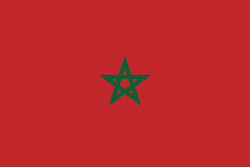Khémisset Province (Khemisset)
Khémisset is a province in the Moroccan economic region of Rabat-Salé-Kénitra. Its population in 2004 is 521,815 This town was founded in 1924 on the site of a military outpost on the road from Rabat to Fes now a provincial capital Khemisset is also the capital of the confederation of the Berber-speaking Zemmour tribes. This is a good place to stop since there are many cafes and restaurants. The town also has a crafts cooperative where you can buy regional specialities, such as carpets and mats woven in palm fibre or wool. Every Tuesday Khemisset is the venue for one of the most important country souks in Morocco, with almost 1900 stalls The major cities and towns are:
* Khemisset
* Mâaziz
* Oulmes
* Rommani
* Sidi Allal El Bahraoui
* Tidass
* Tiflet
The province is divided administratively into the following:
* Khemisset
* Mâaziz
* Oulmes
* Rommani
* Sidi Allal El Bahraoui
* Tidass
* Tiflet
The province is divided administratively into the following:
Map - Khémisset Province (Khemisset)
Map
Country - Morocco
 |
 |
| Flag of Morocco | |
In a region inhabited since the Paleolithic era over 300,000 years ago, the first Moroccan state was established by Idris I in 788. It was subsequently ruled by a series of independent dynasties, reaching its zenith as a regional power in the 11th and 12th centuries, under the Almoravid and Almohad dynasties, when it controlled most of the Iberian Peninsula and the Maghreb. In the 15th and 16th centuries, Morocco faced external threats to its sovereignty, with Portugal seizing some territory and the Ottoman Empire encroaching from the east. The Marinid and Saadi dynasties otherwise resisted foreign domination, and Morocco was the only North African nation to escape Ottoman dominion. The 'Alawi dynasty, which rules the country to this day, seized power in 1631, and over the next two centuries expanded diplomatic and commercial relations with the Western world. Morocco's strategic location near the mouth of the Mediterranean drew renewed European interest; in 1912, France and Spain divided the country into respective protectorates, reserving an international zone in Tangier. Following intermittent riots and revolts against colonial rule, in 1956, Morocco regained its independence and reunified.
Currency / Language
| ISO | Currency | Symbol | Significant figures |
|---|---|---|---|
| MAD | Moroccan dirham | د م. | 2 |
| ISO | Language |
|---|---|
| AR | Arabic language |
| FR | French language |















